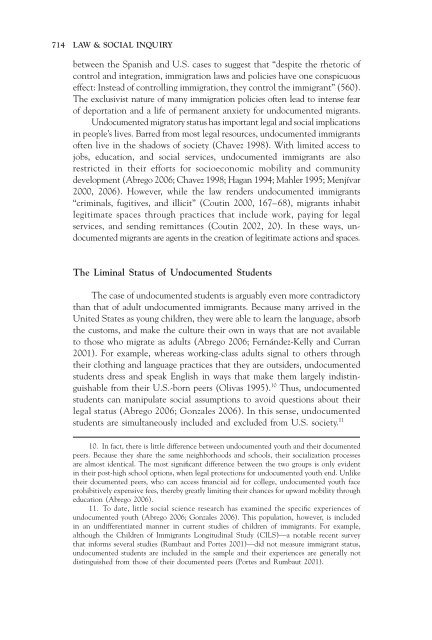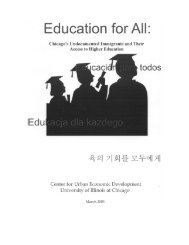Legitimacy, Social Identity, and the Mobilization of Law: The Effects ...
Legitimacy, Social Identity, and the Mobilization of Law: The Effects ...
Legitimacy, Social Identity, and the Mobilization of Law: The Effects ...
You also want an ePaper? Increase the reach of your titles
YUMPU automatically turns print PDFs into web optimized ePapers that Google loves.
714LAW & SOCIAL INQUIRYbetween <strong>the</strong> Spanish <strong>and</strong> U.S. cases to suggest that “despite <strong>the</strong> rhetoric <strong>of</strong>control <strong>and</strong> integration, immigration laws <strong>and</strong> policies have one conspicuouseffect: Instead <strong>of</strong> controlling immigration, <strong>the</strong>y control <strong>the</strong> immigrant” (560).<strong>The</strong> exclusivist nature <strong>of</strong> many immigration policies <strong>of</strong>ten lead to intense fear<strong>of</strong> deportation <strong>and</strong> a life <strong>of</strong> permanent anxiety for undocumented migrants.Undocumented migratory status has important legal <strong>and</strong> social implicationsin people’s lives. Barred from most legal resources, undocumented immigrants<strong>of</strong>ten live in <strong>the</strong> shadows <strong>of</strong> society (Chavez 1998). With limited access tojobs, education, <strong>and</strong> social services, undocumented immigrants are alsorestricted in <strong>the</strong>ir efforts for socioeconomic mobility <strong>and</strong> communitydevelopment (Abrego 2006; Chavez 1998; Hagan 1994; Mahler 1995; Menjívar2000, 2006). However, while <strong>the</strong> law renders undocumented immigrants“criminals, fugitives, <strong>and</strong> illicit” (Coutin 2000, 167–68), migrants inhabitlegitimate spaces through practices that include work, paying for legalservices, <strong>and</strong> sending remittances (Coutin 2002, 20). In <strong>the</strong>se ways, undocumentedmigrants are agents in <strong>the</strong> creation <strong>of</strong> legitimate actions <strong>and</strong> spaces.<strong>The</strong> Liminal Status <strong>of</strong> Undocumented Students<strong>The</strong> case <strong>of</strong> undocumented students is arguably even more contradictorythan that <strong>of</strong> adult undocumented immigrants. Because many arrived in <strong>the</strong>United States as young children, <strong>the</strong>y were able to learn <strong>the</strong> language, absorb<strong>the</strong> customs, <strong>and</strong> make <strong>the</strong> culture <strong>the</strong>ir own in ways that are not availableto those who migrate as adults (Abrego 2006; Fernández-Kelly <strong>and</strong> Curran2001). For example, whereas working-class adults signal to o<strong>the</strong>rs through<strong>the</strong>ir clothing <strong>and</strong> language practices that <strong>the</strong>y are outsiders, undocumentedstudents dress <strong>and</strong> speak English in ways that make <strong>the</strong>m largely indistinguishablefrom <strong>the</strong>ir U.S.-born peers (Olivas 1995). 10 Thus, undocumentedstudents can manipulate social assumptions to avoid questions about <strong>the</strong>irlegal status (Abrego 2006; Gonzales 2006). In this sense, undocumentedstudents are simultaneously included <strong>and</strong> excluded from U.S. society. 1110. In fact, <strong>the</strong>re is little difference between undocumented youth <strong>and</strong> <strong>the</strong>ir documentedpeers. Because <strong>the</strong>y share <strong>the</strong> same neighborhoods <strong>and</strong> schools, <strong>the</strong>ir socialization processesare almost identical. <strong>The</strong> most significant difference between <strong>the</strong> two groups is only evidentin <strong>the</strong>ir post-high school options, when legal protections for undocumented youth end. Unlike<strong>the</strong>ir documented peers, who can access financial aid for college, undocumented youth faceprohibitively expensive fees, <strong>the</strong>reby greatly limiting <strong>the</strong>ir chances for upward mobility througheducation (Abrego 2006).11. To date, little social science research has examined <strong>the</strong> specific experiences <strong>of</strong>undocumented youth (Abrego 2006; Gonzales 2006). This population, however, is includedin an undifferentiated manner in current studies <strong>of</strong> children <strong>of</strong> immigrants. For example,although <strong>the</strong> Children <strong>of</strong> Immigrants Longitudinal Study (CILS)—a notable recent surveythat informs several studies (Rumbaut <strong>and</strong> Portes 2001)—did not measure immigrant status,undocumented students are included in <strong>the</strong> sample <strong>and</strong> <strong>the</strong>ir experiences are generally notdistinguished from those <strong>of</strong> <strong>the</strong>ir documented peers (Portes <strong>and</strong> Rumbaut 2001).






